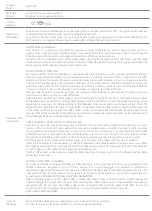
34
E • A burnt compressor (23) can be caused by many factors, so when replacing the compressor (23), we
should observe several items so as not to endanger the service life of the new compressor.
• Clean the condenser gas (25) because bad gas condensation leads to high working pressure
(18kgf/cm2 = 260psig), raising the electric current (higher energy consumption) and the operating
temperature of the compressor's (23) electric motor. In summary, condensation deficiency is a major
cause of compressor (23) burn out.
• Check the fan motor (24) (hood), and if it presents bushings with wear and tear, excessive vibration
and abnormal noise while working, replace the fan (24) motor, preventing its burn out in the short term
which would be likely to compromise the compressor (23), due to poor condensation. During gas
loading, check the low pressure, and if possible the high pressure, to see if they are within normal
ranges. These pressures vary with room temperature, and, as a guideline, there could be a lower
pressure to start the ice cycle, between 0.8 and 1.7kgf/cm2 (11 and 24 psig). The low pressure at the
end of the ice cycle is between 0.5 and 0.8 kg/cm2 (7 and 12 psig). The low pressure during the
defrosting cycle is between 0.5 and 0.8 kg/cm2 (50 and 64 psig). The high pressure varies throughout
the cycle, usually reaching its highest value in the first five minutes of the ice forming phase, but its
maximum value on hot days (temperature of 42°C) should not exceed 17.2 kgf/cm2 (250psig).
During re-installation, do not plug into electrical outlets that have other devices and check whether the
voltage when operating is within the indicated range.
•
Equipment at 127V - from 103 to 135V.
•
Equipment at 220V from 198 to 242V.
The electric current varies due to room temperature, supply voltage and the ice cycle phase (high in the
defrost cycle, medium at the initial stage of ice formation and low at the end). Therefore, it is difficult to
define the correct electrical current, without prefixing the above parameters. As a basis for guidance on
page 02, General Technical Characteristics, the electrical current from the equipment is supplied with
room temperature of 32°C, a supply voltage of 220V or 127V, and an average phase for the formation of
ice cubes.
Содержание EGC 100 A / 150 A
Страница 12: ...OVERVIEW EGC 50A COVER COOLING SYSTEM...
Страница 13: ...OVERVIEW EGC 75A EGC 100A AND EGC 150A In the EGC 150A model there are two compressors and two fans...
Страница 14: ...13 I OVERVIEW EGC 150MA I...
Страница 15: ...14 COOLING SYSTEM EGC 50A EGC 75A EGC 100A AND EGC 150A I COOLING SYSTEM EGC 150MA I...
Страница 16: ...ELECTRICAL ELECTRONIC PART...
Страница 17: ...TROUGH DISPLACEMENT SYSTEM DISPLACEMENT ARM ASSEMBLY TROUGH...
Страница 36: ...35...
Страница 37: ...36 EVEREST REFRIGERA O IND E COM LTDA RESERVES THE RIGHT TO MAKE CHANGES TO ITS EQUIPMENT WITHOUT PRIOR NOTICE...




































